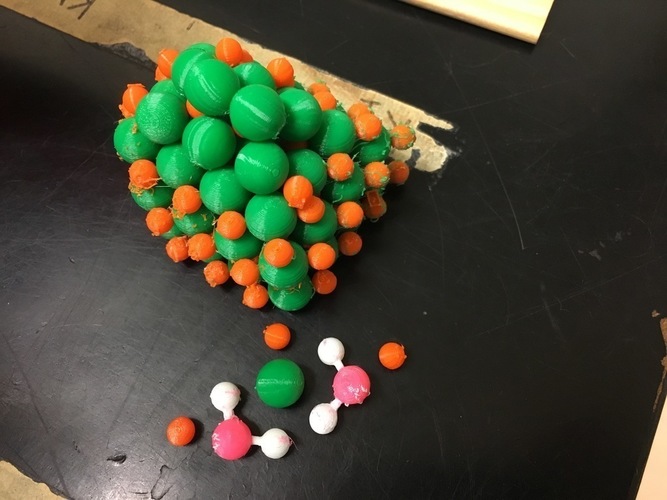
Solubility of an Ionic Compound (NaCl) Model
pinshape
This model showcases the process of ionic compounds like sodium chloride dissolving in water. The sodium (orange) ions and chlorine (green) ions are depicted to scale along with the water molecules. The bulk crystal is face-centered cubic, with separate ions that can be printed and placed on top of the molecule in a repeating structure. Using the included water molecules, the process of dissolving an ionic compound can be demonstrated by removing the individual ions. Files for printing the model are provided for dual extruder printers (recommended) and single extruder printers. For single extruder prints, the individual ions that are placed on top of the model can still be printed in separate colors. Some sodium ions may fall off when removing supports from the model due to their location on the edge of the crystal. Print settings include a Flash Forge Creator Pro printer with rafts and supports enabled. The resolution should be 0.2mm or higher, and infill density should be set at 15%. The following standards are relevant to this activity: NGSS and CCSS. Overview and Background: Many students struggle to grasp the concept of solubility on a particle level. This model can help demonstrate how an ionic compound separates into ions when dissolved, as well as its crystal structure. Before using this model, students should be familiar with the differences between ionic and molecular compounds. Objectives: * Students will describe the process by which an ionic compound dissolves in water. * Students will explain how water molecules interact with ionic compounds through intermolecular forces. * Students will explain why certain substances can form crystal structures. Lesson Plan and Activity: Begin by showing students some table salt and asking what will occur when the compound is dropped in water. Discuss what happens on a macro level (it dissolves) and then ask students to draw what they think will happen on a particle level. Show the model of sodium chloride already set up with one or more layers of individual ion pieces on top. Pour some water on the model by dropping the included water molecules onto the model, knocking the individual ions off the crystal. This can lead to discussions about how water molecules interact with positive and negative ions through ion-dipole forces, why the ions break apart, and about how the surface of the crystal must dissolve before the interior. Materials Needed: No additional materials are required besides the model kit, although a document camera may be helpful in demonstrating how the model works.
With this file you will be able to print Solubility of an Ionic Compound (NaCl) Model with your 3D printer. Click on the button and save the file on your computer to work, edit or customize your design. You can also find more 3D designs for printers on Solubility of an Ionic Compound (NaCl) Model.
